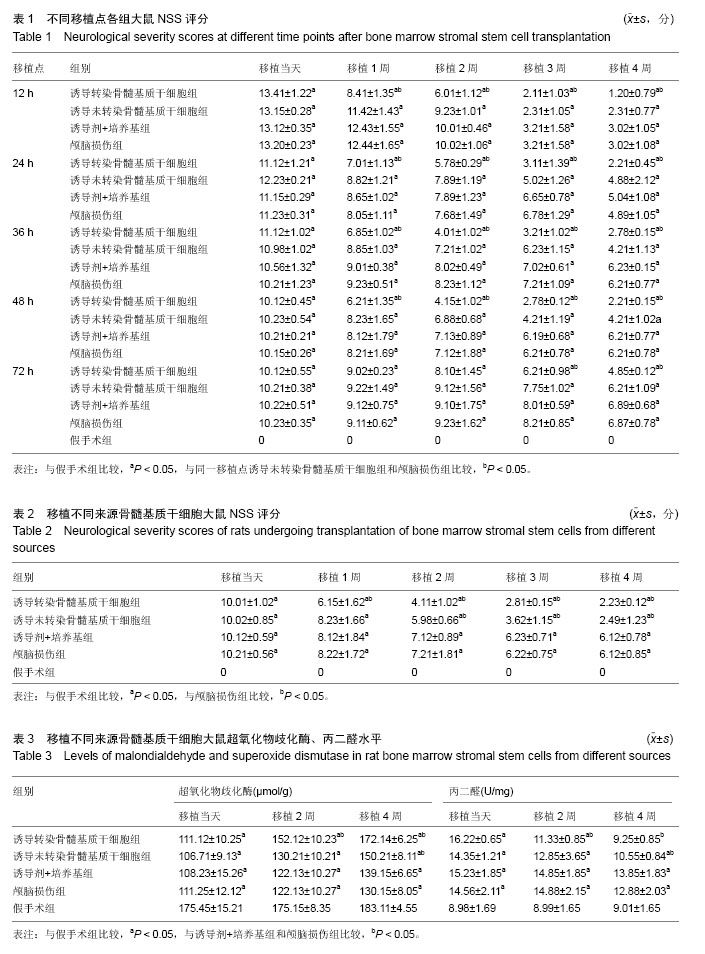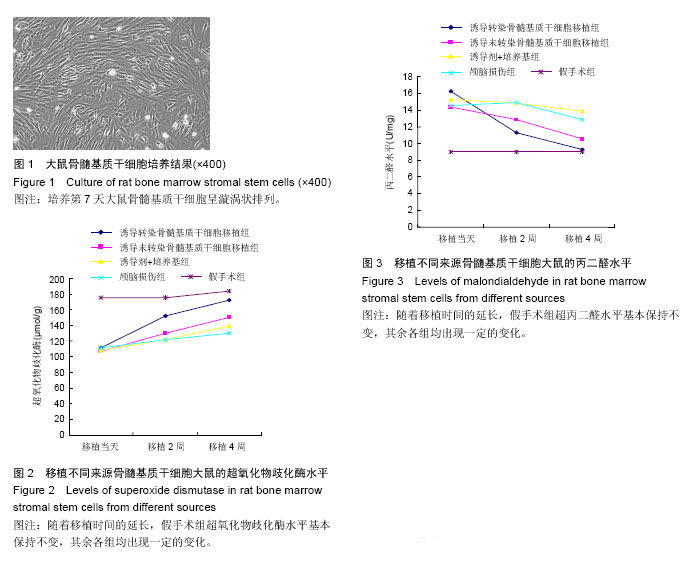| [1] 张震宇,温二生,薛进华,等.移植转染大鼠骨髓基质干细胞对颅脑损伤大鼠的保护作用[J].广东医学,2013,34(8): 1163-1166.
[2] 唐军,刘广鹏,李新庆,等.9例应用组织工程骨修复颅骨缺损患者的护理[J].中华护理杂志,2010,45(7):660-661.
[3] 樊欣鑫.超顺磁氧化铁标记骨髓基质干细胞联合施万细胞移植治疗颅脑损伤大鼠及活体MR示踪的实验研究[D].南京:东南大学,2013.
[4] 玉石.骨髓基质干细胞体外诱导分化及移植治疗脑外伤患者的临床观察[D].西安:第四军医大学,2009.
[5] 薛蓬,陈镇洲,刘钊,等.骨髓源性神经干细胞诱导分化及移植治疗颅脑损伤[J].中国组织工程研究与临床康复,2007, 11(7):1271-1273,1404.
[6] Taniguchi Ishikawa E, Gonzalez-Nieto D, Ghiaur G, et al. Connexin-43 prevents hematopoietic stem cell senescence through transfer of reactive oxygen species to bone marrow stromal cells. Proc Natl Acad Sci U S A. 2012;109(23):9071-9076.
[7] Schagemann JC, Paul S, Casper ME, et al. Chondrogenic differentiation of bone marrow-derived mesenchymal stromal cells via biomimetic and bioactive poly-ε-caprolactone scaffolds. J Biomed Mater Res A. 2013;101(6):1620-1628.
[8] Zhang JC,Liu DD,Sun J, et al. Effect of Dy3+on osteogenic and adipogenic differentiation of mouse primary bone marrow stromal cells and adipocytic trans-differentiation of mouse primary osteoblasts. Chinese Science Bulletin. 2009; 54(1):66-71.
[9] 刁新峰,程立敏,薛咏,等.立体定向脑内移植神经干细胞改善颅脑损伤大鼠的神经运动功能[J].中国组织工程研究, 2016,20(10):1446-1451.
[10] 孙榕呈,佘晓春,王晓冬,等.纵裂水瘤作为重度颅脑损伤去骨瓣减压术后并发脑积水预警言号的临床分析[C].第二届中国医师协会神经损伤年会暨第二届天坛全国神经创伤学术研讨会论文集,2013:203-208.
[11] 车彦军,刘灿均,倪衡建,等.骨髓基质细胞侧脑室移植对创伤性颅脑损伤鼠认知功能的影响[J].中国微侵袭神经外科杂志,2011,16(12):563-566.
[12] Mastrogiacomo M, Papadimitropoulos A, Cedola A, et al. Engineering of bone using bone marrow stromal cells and a silicon-stabilized tricalcium phosphate bioceramic: evidence for a coupling between bone formation and scaffold resorption. Biomaterials. 2007;28(7):1376-1384.
[13] Melief SM, Schrama E, Brugman MH, et al. Multipotent stromal cells induce human regulatory T cells through a novel pathway involving skewing of monocytes toward anti-inflammatory macrophages. Stem Cells. 2013;31(9):1980-1991.
[14] Papadimitropoulos A, Mastrogiacomo M, Peyrin F, et al. Kinetics of in vivo bone deposition by bone marrow stromal cells within a resorbable porous calcium phosphate scaffold: an X-ray computed microtomography study. Biotechnol Bioeng. 2007;98(1):271-281.
[15] Oliveira JM, Rodrigues MT, Silva SS, et al. Novel hydroxyapatite/chitosan bilayered scaffold for osteochondral tissue-engineering applications: Scaffold design and its performance when seeded with goat bone marrow stromal cells. Biomaterials. 2006; 27(36):6123-6137.
[16] 周苏键,谭耀武,刘咏武栎,等.高压氧对创伤性颅脑损伤大鼠神经保护作用及骨髓间充质干细胞归巢因子表达的影响[J].中华航海医学与高气压医学杂志,2015,22(5): 347-351.
[17] 王崇谦,丁鹏,牟临杰,等.颅脑损伤后内源性神经干细胞增殖与迁移中的基质细胞衍生因子1[J].中国组织工程研究, 2012,16(6):998-1002.
[18] Kishimoto S, Ishihara M, Mori Y, et al. Effective expansion of human adipose-derived stromal cells and bone marrow-derived mesenchymal stem cells cultured on a fragmin/protamine nanoparticles-coated substratum with human platelet-rich plasma. J Tissue Eng Regen Med. 2013;7(12):955-964.
[19] Jiang J, Fan CY, Zeng BF. Osteogenic differentiation effects on rat bone marrow-derived mesenchymal stromal cells by lentivirus-mediated co-transfection of human BMP2 gene and VEGF165 gene. Biotechnol Lett. 2008;30(2):197-203.
[20] 李长栋,荔志云,白海,等.大黄素甲醚联合脐带间充质干细胞移植对创伤性脑损伤大鼠MMP-9和TIMP-1蛋白酶的影响[J].创伤外科杂志,2013,15(4):306-309.
[21] Lu XL,Jia D,Zhao CG,et al.Recombinant adenovirus- mediated overexpression of 3β-hydroxysteroid-Δ24 reductase. Neural Regen Res. 2014;9(5): 504-512
[22] 高伟,雷鹏,周杰,等.脂肪源性干细胞移植对颅脑损伤大鼠神经功能评分和神经细胞凋亡的影响[J].中国康复医学杂志,2010,25(11):1040-1043.
[23] Ueda T, Fujita A, Ogawa R, et al. Adipose-derived stromal cells grown on a hydroxyapatite scaffold can support hematopoiesis in regenerated bone marrow in vivo. Cell Biol Int. 2014;38(6):790-798.
[24] Guang LG, Boskey AL, Zhu W. Age-related CXC chemokine receptor-4-deficiency impairs osteogenic differentiation potency of mouse bone marrow mesenchymal stromal stem cells. Int J Biochem Cell Biol. 2013;45(8):1813-1820.
[25] 李云,彭春,王玮,等.脑卒中后抑郁大鼠海马和丘脑神经生长因子及其受体的表达变化[J].中华老年心脑血管病杂志,2015,17(12):1305-1309.
[26] 李荣双,范淑玲,李立平,等.真核细胞翻译延伸因子2参与神经生长因子诱导的大鼠嗜铬细胞瘤细胞的分化[J].中国老年学杂志,2015,35(23):6720-6721.
[27] 闫旭,明磊国,罗鹏,等.骨髓间充质干细胞膜片结合冻存自体骨瓣修复兔颅骨极限缺损[J].中华神经医学杂志,2014, 13(5):438-441.
[28] Veronesi E, Murgia A, Caselli A, et al. Transportation conditions for prompt use of ex vivo expanded and freshly harvested clinical-grade bone marrow mesenchymal stromal/stem cells for bone regeneration. Tissue Eng Part C Methods. 2014;20(3):239251.
[29] Wei N, Yu Y, Schmidt T, et al. Effects of glucocorticoid receptor antagonist, RU486, on the proliferative and differentiation capabilities of bone marrow mesenchymal stromal cells in ovariectomized rats. J Orthop Res. 2013;31(5):760-767.
[30] 赵建华,吴磊,冯继,等.骨髓基质干细胞治疗创伤性脑损伤实验研究[J].中华神经外科疾病研究杂志,2011,10(1): 8-11.
[31] 初海平.骨髓基质干细胞对大鼠急性一氧化碳中毒脑损伤的作用及机制研究[D].济南:山东大学,2009.
[32] Gershovich PM, Gershovich JG, Zhambalova AP, et al. Cytoskeletal proteins and stem cell markers gene expression in human bone marrow mesenchymal stromal cells after different periods of simulated microgravity.Acta Astronautica. 2012; 70(1):36-42.
[33] Inoue H, Murakami T, Ajiki T, et al. Bioimaging assessment and effect of skin wound healing using bone-marrow-derived mesenchymal stromal cells with the artificial dermis in diabetic rats. J Biomed Opt. 2008; 13(6):064036.
[34] 张鹏.骨髓源神经干细胞联合基质胶修复大鼠脑损伤及动态MEMRI成像大鼠视皮层实验研究[D].广州:南方医科大学,2010.
[35] 王永志,冯东福.骨髓基质细胞治疗颅脑外伤的研究进展[J].蚌埠医学院学报,2010,35(3):313-315.
[36] Jiang S, Zagozdzon R, Jorda MA, et al. Endocannabinoids are expressed in bone marrow stromal niches and play a role in interactions of hematopoietic stem and progenitor cells with the bone marrow microenvironment. J Biol Chem. 2010; 285(46): 35471-35478.
[37] 黄志锋,张翼,郑青,等.碱性成纤维细胞生长因子对骨髓间质干细胞的作用[J].江苏药学与临床研究,2006,14(2): 81-84.
[38] 李钢,徐如祥,柯以铨,等.脑皮层创伤灶注射法移植神经干细胞实验研究[J].中华神经医学杂志,2008,7(2):125-130.
[39] 李钢.成年食蟹猴骨髓基质细胞的诱导分化及移植修复脑皮层损伤[D].广州:第一军医大学,2003. |
.jpg)


.jpg)
.jpg)